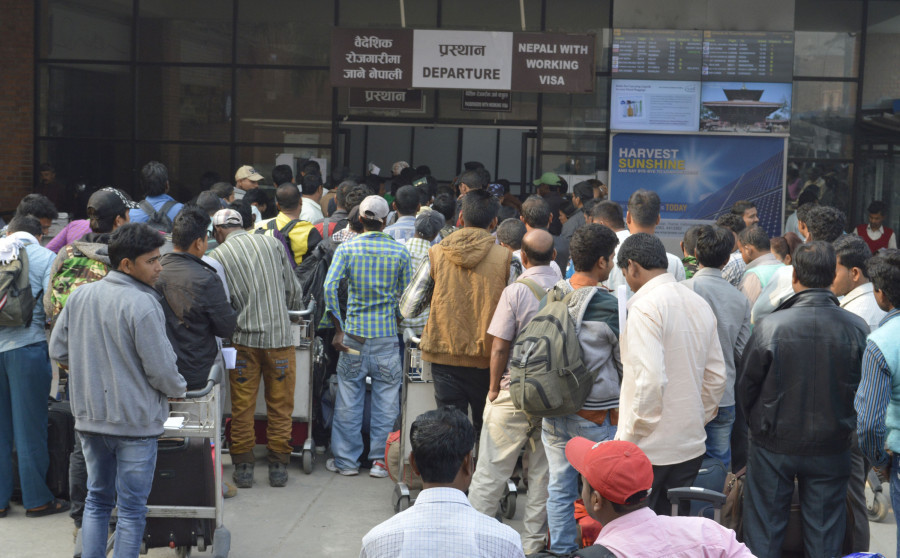Money
Remittance defies projections of a massive drop
Nepal received Rs 100.16 billion in remittance, an all-time high during mid-June to mid-July—the last month of the last fiscal year—that boosted the overall earnings.
Sangam Prasain
Remittance inflows dropped by a marginal 0.5 percent in the last fiscal year that ended mid-July, despite popular labour markets in the Gulf Cooperation Council countries and Malaysia being severely impacted by the Covid-19 pandemic that left millions of expat workers with no choice but to pack their bags and leave.
According to the Nepal Rastra Bank’s annual macroeconomic report released on Monday, Nepali migrant workers sent home Rs 875.03 billion in the last fiscal year. The report shows that Nepal received an all-time high remittance of Rs 100.16 billion during the last month of the fiscal year (mid-June to mid-July) that boosted the overall remittance earning.
The central bank said that the number of Nepali workers seeking approval for foreign employment decreased by 20.5 percent to 193,945 individuals in the review period. Similarly, the number of Nepali workers (renew entry) seeking approval for foreign employment decreased 34.7 percent to 177,980 individuals in the last fiscal year.
“We had initially expected that Covid-19 would cause a severe contraction to remittance earning as tens of thousands of Nepalis were reported to return home,” said Gunakar Bhatta, spokesperson for the country’s central bank. “But the country did not see migrant workers returning home in big volumes.”
He said that migrant workers may have felt safe to live where they were given the ill-preparation to deal with the Covid-19 pandemic at home. Some labour rights activists said that the high airfare cost was the key reason thousands of migrant workers could not fly back home from different labour destinations.
As of Monday, according to Covid-19 Crisis Management Centre statistics, more than 52,000 Nepalis have returned home—majority of them from the labour destinations.
According to the centre, the highest arrivals of 14,745 were from the United Arab Emirates, followed by Saudi Arabia 7,817 and Malaysia 7,795. Similarly, 6,320 returned home from Kuwait and 5,668 from Qatar.
In April-end, a little over a month after the lockdown was imposed on March 24, the Nepal Rastra Bank had projected a drop of over 15 percent in remittances in the last fiscal year 2019-20. In the same month, the World Bank also projected remittances to go down by 14 percent. Similarly, the Central Bureau of Statistics also projected a reduction of Rs163 billion, or over 18 percent.
“But all of their assumptions were wrong,” said Bhatta.
He said that the estimate was based on April’s remittance earnings that saw a sharp drop. However, after April, there had been a noticeable improvement in remittances.
There are few factors, according to Bhatta, which did not affect the remittance much.
“As the source countries, mainly Saudi Arabia, Bahrain, Qatar, the United Arab Emirates and Oman are still continuing their manufacturing activities, migrant workers have not been laid off in expected numbers,” said Bhatta. “We have also estimated that the informal trade has decreased by the restrictions and lockdowns that eventually have helped remittance come through formal channels.
According to Bhatta, remittance in large chunks is coming through formal channels unlike in the past.
“Besides, migrant workers who have returned home may have brought back their savings,” Bhatta, who is also the chief of the central bank’s research department, told the Post. “The outlook, too, is not disappointing as international crude oil prices have started to increase, backed by renewal orders from China.”
As falling oil prices will affect remittance outflows from GCC countries and Malaysia, the gradual recovery will mean demand for workers will also rise gradually, according to him.
In the United Arab Emirates and Qatar, foreign workers make up 91 percent of the population. In Saudi Arabia, foreign workers make up two-thirds, according to a report.




 11.12°C Kathmandu
11.12°C Kathmandu















